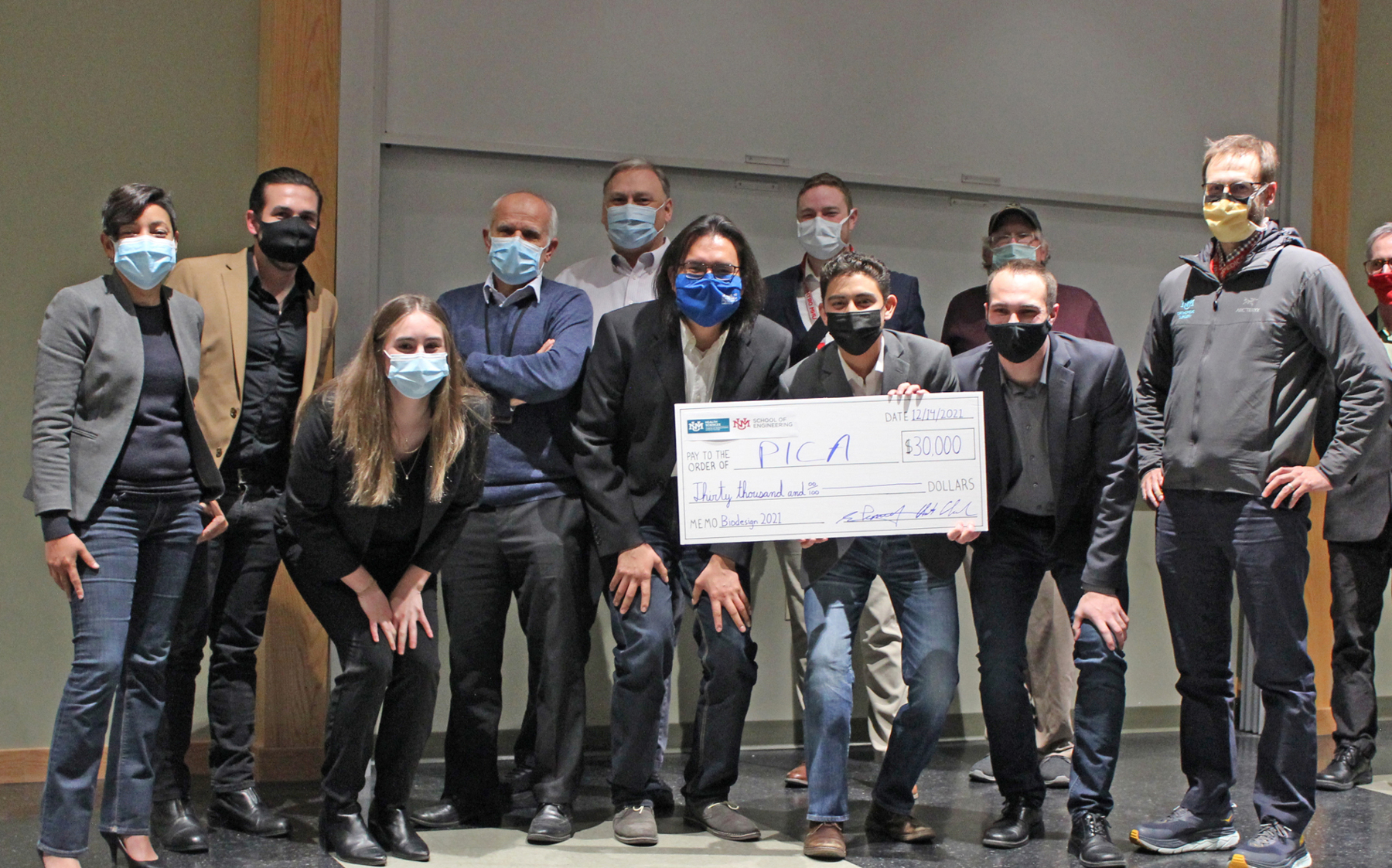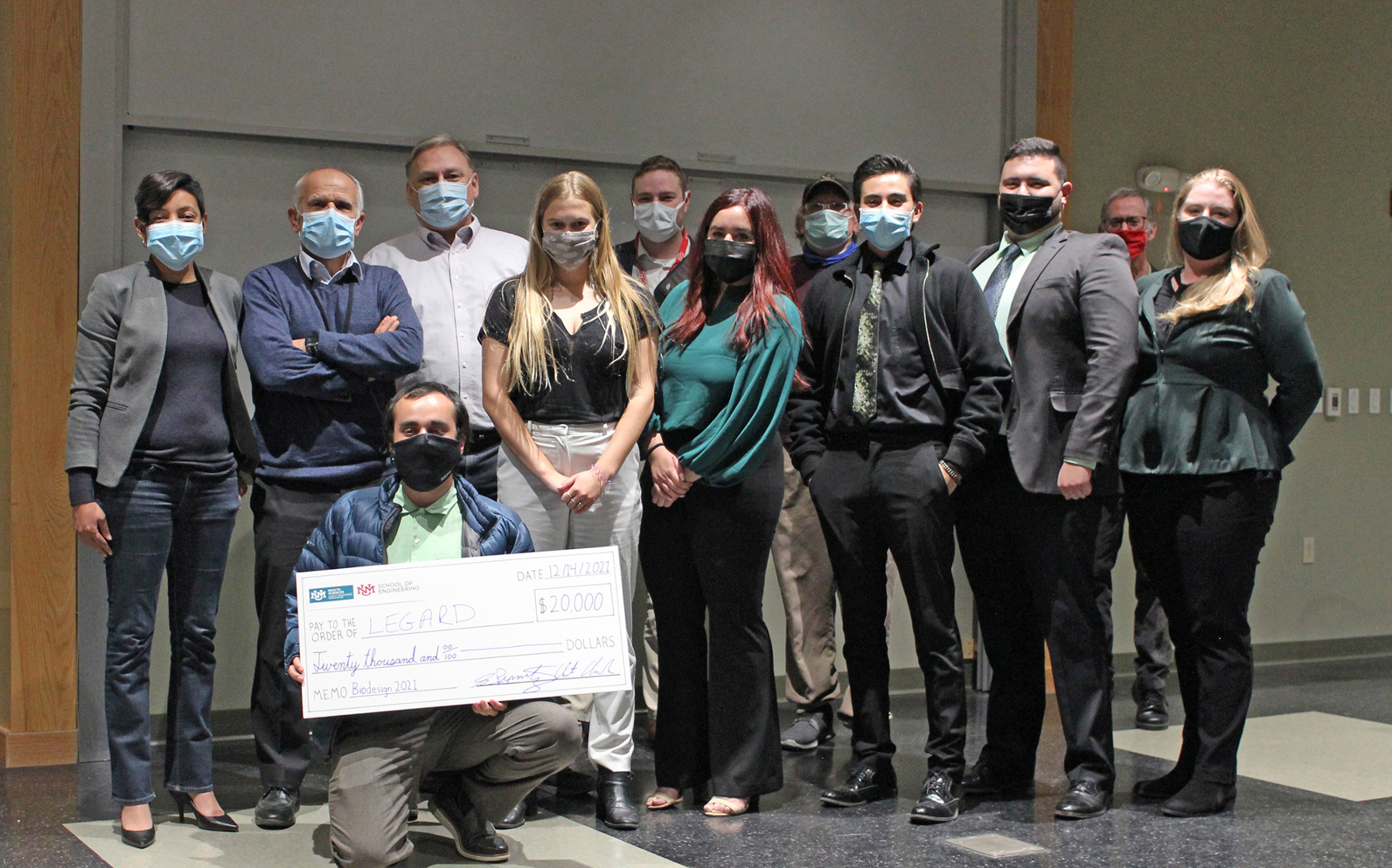Recent News
New director will enhance interdisciplinary engineering learning opportunities
July 2, 2025
Final SIRI cohort visits UNM campus
June 30, 2025
Perfetti receives ANS Landis Engineering Achievement Award
June 26, 2025
Engineering a new treatment for ovarian cancer
June 24, 2025
News Archives
Two teams win $50K in prize money in biodesign course competition
December 17, 2021 - By Kim Delker
Two student teams won $50,000 in awards in the annual biodesign contest Dec. 14, jointly sponsored by the School of Engineering and the Clinical and Translational Science Center in the School of Medicine at The University of New Mexico.
The contest is part of a graduate-level Biodesign course that tasks students with addressing common problems that professionals in the medical field face. Student teams are then challenged to come up with innovative products and devices that address those needs and must provide a budget and a plan for further developing and commercializing their technology.

Student teams presented their ideas to a panel of judges — including experts in engineering, business and the medical field — who then made the final selections.
Each year, a clinical focus area is chosen, and this year it was on orthopedics.
The first-place team, winning $30,000, was “PICA – Prosthetic Implant for Carpometacarpal Arthritis.” PICA offers a treatment for a painful and common condition that currently has no definitive solution. The PICA device would be implanted in the thumb to constrain the CMC joint to resolve pain and maintain thumb strength in patients with severe osteoarthritis.
Students on this team were Ethan Darwin, a master’s student in mechanical engineering; August Finke, a master’s student in chemical engineering; Dimitri Madden, a Ph.D. student in mechanical engineering; and Lauren Ostermann and Diego Rodriguez, both undergraduates in chemical and biological engineering.
The second-place team, which won $20,000 to further develop, test and commercialize their invention, was “Lower-Extremity Guided Assisted Rehabilitation Device (L.E.G.A.R.D.).” L.E.G.A.R.D. addresses the problem of rehabilitative physical therapy following total hip replacement surgery. Although the surgery is commonplace, many barriers exist to patients receiving adequate rehabilitative care, which may limit functional recovery and quality of life of the patient. This is especially true in rural areas of New Mexico, where many patients live far from physical therapy facilities.

The innovation involves a devise that allows patients to rehabilitate at home, with guidance and feedback provided through an app.
Students on this team were Tara Memarian, Leonard Ruggiero and Adam Magaña, master’s students in biomedical engineering; Elias Rosales-Zaragoza, an undergraduate in mechanical engineering; Katherine Miles, a master’s student in mechanical engineering; Tybur Casuse Driovinto, a Ph.D. student at the Center for Micro-engineered Materials; and Rebekah Gridley, a master’s student in exercise science,
Other teams who presented were:
“3D Printed Synthetic Osteochondral Graft,” with students Emily Rhoades-Clark, a Ph.D. student in engineering; Jawad Khalaf and Samuel McKitrick, both master’s students in biomedical engineering; and Daniel Seligman and Matthew Aragon, both master’s students in mechanical engineering.
“Framewerk: The Foundation of Improve Rehabilitation,” with students Maren Baur, an undergraduate in biomedical and mechanical engineering; Jorge Canales Verdial, a Ph.D. student in electrical engineering; Nika Mitchell, a master’s student in biomedical engineering; Ethan Schmidt, a master’s student in mechanical engineering; Laura Stacy, a master’s student in biomedical engineering; and Rocio Vasquez, a graduate student in mechanical engineering.
“CIIBR: Chemically Illuminating Adhesive for Arthroscopic Instrument Breakage,” with students Rachel Habing, Sara Hasan and Gabriela Lucero, all master’s students in biomedical engineering; and Claire O’Malley, an undergraduate in mechanical engineering.
Judges for the contest were Sara Boisvert, an entrepreneur and founder of New Collar Network and Fab Lab Hub; Christos Christodoulou, Jim and Ellen King Dean of Engineering and Computing; Yorgos Marinakis, an assistant professor in the Anderson School of Management; Eric Prossnitz, a distinguished professor in the Department of Internal Medicine, Division of Molecular Medicine; Christopher Shultz, a physician and assistant professor in orthopedic surgery at UNM Sandoval Regional Medical Center; and Steven Walsh, a distinguished professor in the Anderson School of Management.
The graduate-level Biodesign course is directed by Christina Salas, an associate professor with the Department of Orthopaedics & Rehabilitation who also is special assistant to the dean of engineering for Health Sciences relations. Salas said the Biodesign course is modeled after a similar program at Stanford University.
During the semester, students get a crash course in the medical specialty selected for that year — talking to doctors, nurses, and patients and touring important medical facilities to learn about real-life clinical challenges that are waiting on a solution. Students spend two to three weeks in this medical setting, immersing themselves in clinical problems and familiarizing themselves with the medical specialty. Then, supervised by Dr. Salas, break up into teams to research and design a technology that can address a clinical problem in that specialty.
At the end of the semester, student teams disclose their technology to the UNM Rainforest Innovations, UNM’s technology transfer office, submit a provisional patent application to protect their technology, and compete for funding of up to $50,000 to support fabrication, testing, and commercialization of their new product. The winning team’s award is funded by the School of Medicine’s Clinical and Translational Science Center and the School of Engineering.
Work on each winning design continues for at least a year after the semester ends, with Salas serving as a mentor resource. After the semester, students can continue to work on their technologies by signing up for an independent study course with their faculty lead.
Salas said the course primarily attracts health sciences and engineering students, but it is open to most majors that allow electives from the School of Engineering.
